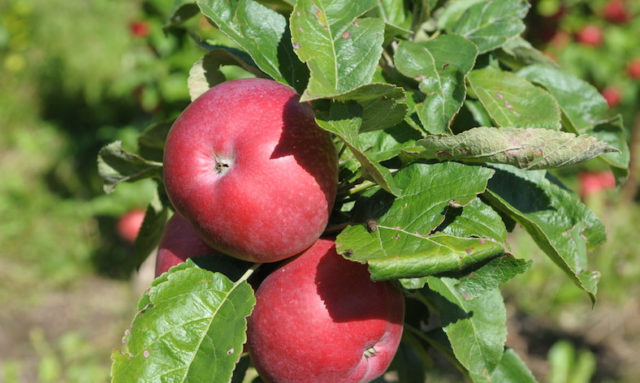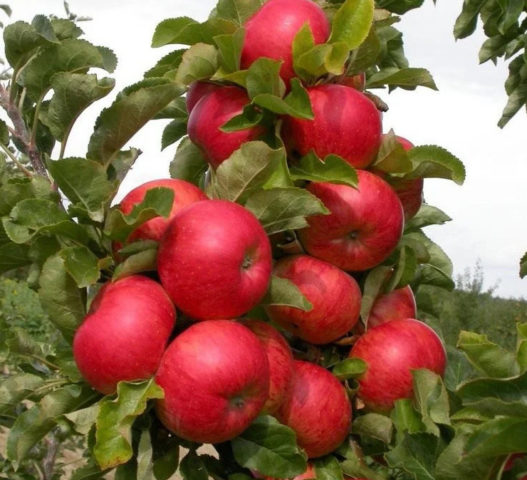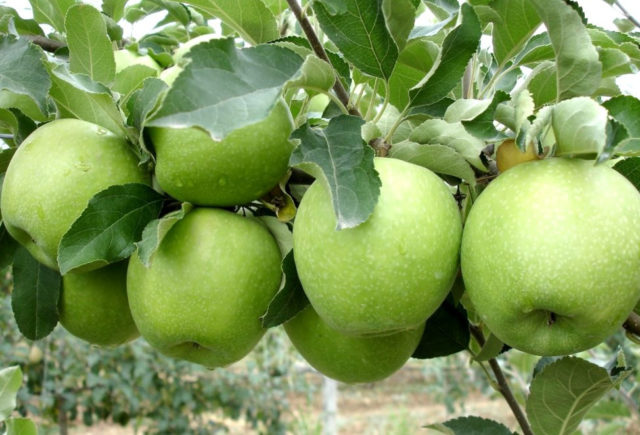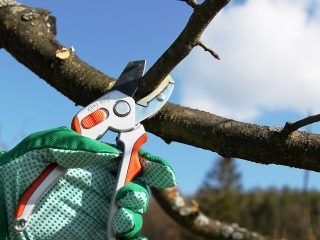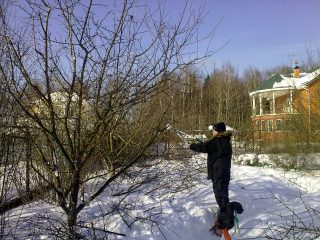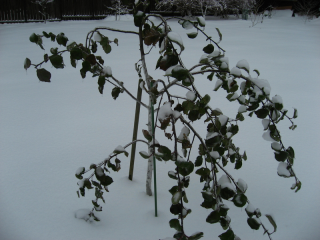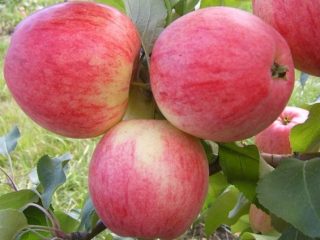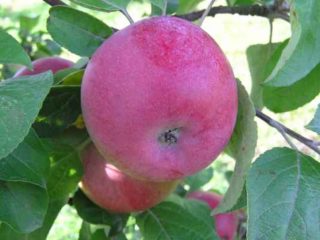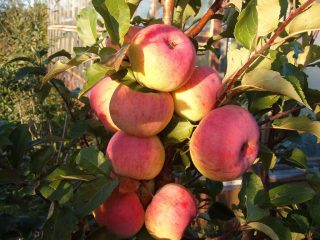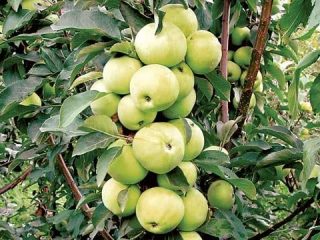Content
Among the many varieties and types of fruit, the columnar apple tree Amber Necklace (Yantarnoe Ozherelie) always attracts attention. It is distinguished by its unusual appearance, compactness and productivity. Gardeners appreciated the opportunity to create an unusual garden with graceful trees that produce a large harvest of beautiful, high-quality apples.
History of selection
Creating miniature fruit trees is one of the tasks of breeders, which they successfully solve. Candidate of Agricultural Sciences M.V. Kachalkin has been breeding columnar apple trees for a long time. At a breeding nursery in the Kaluga region, he obtained 13 species with these parameters. One of them is “Amber Necklace”, bred as a result of open pollination by the “Vozhak” variety. After successfully passing the test in 2008, the new columnar variety was included in the State Register of the Russian Federation.

The tree is resistant to low temperatures and can survive without water for some time.
Characteristics of the columnar apple tree Amber Necklace
Columnar trees are very suitable for creating a garden in a small area. Their crowns are compact, harvesting is easy, and the fruits are of high quality. There are other distinctive features.
Appearance of fruit and tree
Depending on what rootstock was used, a mature Amber Necklace apple tree reaches a height of 1.5 m to 3.5 m.
The fruit tree of the “Amber Necklace” variety develops quickly—it can grow 60 cm in a season. By the fifth year of life, it reaches its maximum height and no longer grows upward.
The size of the fruit depends on the number of ovaries formed. The average weight of each is 160 g, the maximum is up to 320 g. The shape is round, even, flattened at the “poles”. The skin is dense, yellow in color with a slight blush on the side or near the stalk.
Lifespan
The lifespan of the columnar apple tree “Amber Necklace” is significantly less than that of ordinary species. In 9-10 years, their fruiting is significantly reduced, and after another 7-8 years the trees are replaced with new ones.
Taste
The fruits have juicy, cream-colored pulp of medium density. If they ripen on the branches, they become filled with sugar and the flesh becomes translucent. Apples of the “Amber Necklace” variety are sweetish, with a subtle fruity aroma. Tasting score: 4.3 points, universal use.

The height of an adult apple tree can reach up to 3.5 meters
Growing regions
The winter hardiness of the columnar variety “Amber Necklace” allows us to recommend it for cultivation in zone 4 of frost resistance. It is zoned for most regions of the Central Federal District - Kaluga, Moscow, Smolensk, Tula and Ryazan regions.
It is possible to grow a columnar apple tree in regions with a more severe climate, but additional preparatory work will have to be done for wintering.
Productivity
The “Amber Necklace” variety produces the first harvest starting from the third year of life. At this age, up to 5-6 kg of fruits are obtained from one columnar apple tree. In the sixth year, up to 20 kg are harvested. In order for the harvest to be stable and the fruits to be of high quality, trees need careful care.
Frost resistance
The columnar apple tree “Amber Necklace” tolerates winters with temperatures dropping to -34 ⁰C. To guarantee wintering during winters with little snow, the crown is covered and the soil near the trunk is mulched.
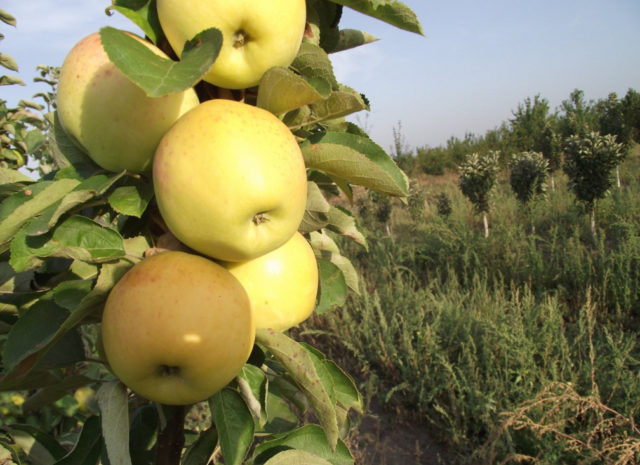
The fruits ripen in the second half of September
Resistance to diseases and pests
Thanks to the columnar structure of the crown, the apple tree does not have thickening or shading of the branches, the humidity inside them does not rise above normal, which contributes to the plant’s resistance to fungal diseases. Scab and powdery mildew also rarely affect the Amber Necklace variety, since the crowns are well ventilated.
Most often, columnar varieties are affected by cancer, rust, mosaic or viral spotting. For preventative purposes, many gardeners treat the crowns with a solution of Bordeaux mixture in early spring and autumn, and, often, this is enough to eliminate the possibility of disease. If pathology cannot be avoided, fungicides are used.
Of all the known insect pests, aphids appear most often on columnar varieties, and insecticides help get rid of them.
For small lesions, traditional methods are used: a solution of laundry soap with an infusion of yarrow, tobacco or ash.
Flowering period and ripening period
During the flowering period, the columnar apple tree “Amber Necklace” looks very impressive. The first buds appear in the second year of life, but they should be removed in order to direct energy to the development of roots and crowns.
In the central regions of the Russian Federation, at the end of April, the entire crown is covered with small snow-white flowers. In the northern regions, flowering occurs 2-3 weeks later. Apples of the “Amber Necklace” variety ripen late. Harvesting takes place in September.
Pollinators of the columnar apple tree Amber Necklace
The variety is self-sterile. It needs pollination by other columnar apple trees that coincide in flowering time. Breeders recommend several varieties:
- Constellation (Sozvezdie).
- Barguzin.
- Statistics (Statistica).
Transportation and keeping quality
The fruits of the columnar apple tree are transportable. Thanks to the dense structure of the skin and strong pulp, apples do not lose their presentation and are not damaged when transported over long distances. The fruits are stored for a long time. When placed in the basement, their integrity and nutritional properties are maintained until March.
Advantages and disadvantages
The advantages of the variety include:
- ease of care and collection of fruits due to the compact size of the tree;
- the possibility of growing vegetable crops in the garden due to the low shading of the area created by columnar apple trees;
- early and abundant fruiting;
- pleasant taste of fruits;
- long (up to six months) shelf life;
- attractive appearance of apples;
- excellent transportability;
- frost resistance;
- plant resistance to diseases and damage by insect pests.
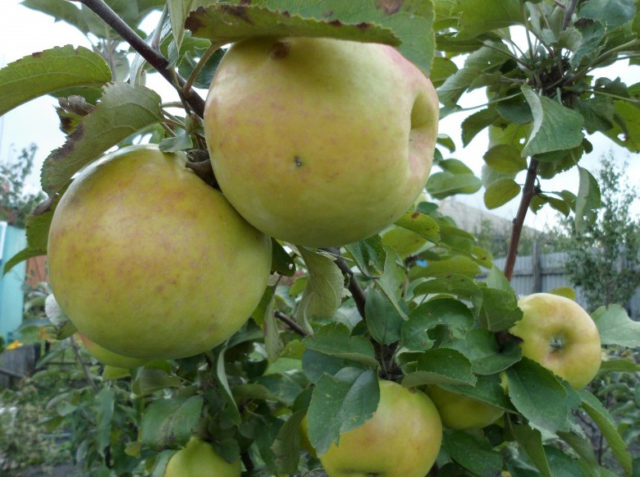
The variety “Amber Necklace” has no interruptions in fruiting
There are not many disadvantages to the columnar apple tree:
- With a large harvest, the trunk requires tying to a support.
- Compared to ordinary apple trees, columnar apple trees do not bear fruit for long - about 10-15 years, after which they are replaced.
Landing
According to the recommendations of experts, columnar apple trees are planted in the spring, after the soil has warmed to +14 ⁰C, or in the fall, two weeks before frost.
When choosing seedlings, preference is given to annual ones, with a developed root system, without damage or rot. Plants with dried out roots should not be purchased; the best option is a seedling in a container.
For planting, choose an open sunny area, protected from northern winds and drafts. You should not plant a garden in a place with groundwater located above two meters.
Dig holes 0.6 x 0.6 x 0.6 m, placing them at a distance of half a meter from each other. A gap of 1 meter is left between the rows. Compost is poured onto the bottom, superphosphate and potassium (2 tablespoons each) and 50 g of dolomite flour are added if the soil is acidified.
After keeping the seedling in warm water for 10 hours, begin planting. To do this, place it in the center of the planting hole, sprinkle it with soil and compact it a little. Next, the tree is tied to a support, watered with warm water, and the soil is mulched.
Growing and care
After planting, the seedlings are regularly watered, keeping the soil moist. Feeding is carried out twice per season.For this purpose, ammonium nitrate is added to the soil during the period of bud break, and in the summer - phosphorus-potassium fertilizer.
Columnar apple trees require virtually no pruning. In spring, only damaged or frozen shoots are removed.

In equipped warehouses where all conditions are met, apples of the “Amber Necklace” variety do not spoil until summer
We must not forget about the prevention of pathologies and the timely destruction of pests.
Collection and storage
For storage, apples are harvested in the third ten days of September. They reach the best consumer qualities a month or 1.5 after harvesting.
The columnar variety “Amber Necklace” has a universal purpose. Juices, compotes, jams and confitures are prepared from the fruits. When stored in a cool room, they do not deteriorate until spring.
Conclusion
The columnar apple tree Amber Necklace is a real find for gardeners. Thanks to its compactness, many seedlings can be planted on the site, which will produce a rich harvest of high-quality fruits for many years.
Reviews
